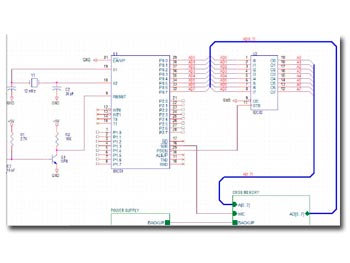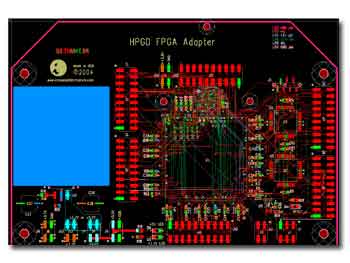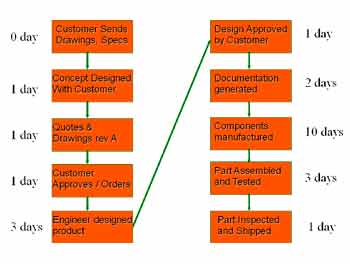Turn-key Capabilities – RoHS Compliant
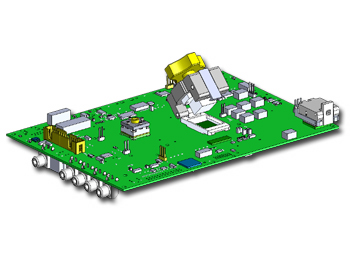

Complete turn-key solution involves design service, component procurement service, component manufacturing, final assembly, X-ray/AOI service, functional/parametric testing and customized packaging.
Our in house design service utilizes state-of-the-art PCB/CAD software such as Solidworks 3D modeling, Orcad electrical schematic capture, Pads PCB layout, Pads auto router, CAM 350 etc. 3D modeling of subsystems allows end user to integrate subsystems to their main system board and analyze mechanical constraints, height restriction, etc. before moving towards manufacturing. We take your electrical schematic and generate net list using our Orcad capture software. Then, we use Pads layout software to design the subsystem. We possess knowledge of PCB layout rules for wide variety of components including Ironwood proprietary fine pitch interconnects systems. We use Pads auto router and verify the net list for accuracy. We use DRC (Design Rule Check) for 2nd level verification. Finally, we perform 3rd verification using CAM350 for Gerber data before sent out for fabrication.
Our CPT, CPPM and CIPM certified component procurement specialists have buying experience with most of IC manufacturers, discrete devices, high speed connector interfaces and other specialized components necessary for electronic modules. Since we are an ISO certified company, we establish rigorous quality standards for our supplier base. We have reliable vendors whom we audit consistently to maintain lead time and best possible pricing.
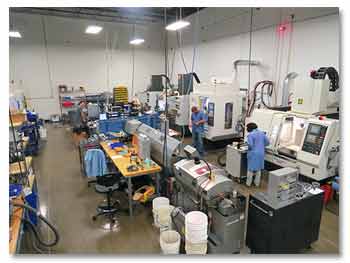
In-house Machining Capabilities

In-house Machining Capabilities
We have in-house machining capabilities using best-in-class CNC machines for custom fixture fabrication enabling easy and precise assembly functions. The assembly function starts with screen printing process. We use top of the line DEK solder paste printer that has new camera support arms and a single point release button to reduce set-up time. These cost savings are directly passed on to customers. For more accurate positioning the linear bearing system in the DEK printer ensures smooth, robust motion when aligning the cameras to the PCB. Also we have optimized the process by analyzing variables such as solder paste solution concentration, screen aperture dimensions, squeegee material, squeegee angle and speed. These enable appropriate solder quantity in PCB assembly without tomb stoning or head in pillow effects, etc.
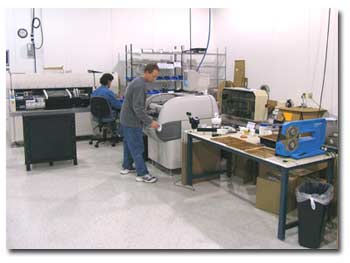
SMT Assembly Line

SMT Assembly Line
My Data equipment for pick & place assembly is capable of placing 0201 and the ability to take on all types of high-mix production at low to medium volume. Reduced set up & change over time using lean manufacturing principle enables smooth flow of parts and thus resulting in low cycle time even when the jobs are complex or the batch sizes vary. This means low manufacturing cost for the buyer even when the quantities are low to medium.
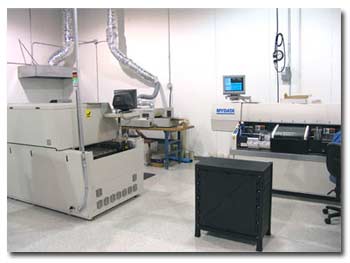
Heller Reflow Convection Oven

Heller Reflow Convection Oven
After pick & place assembly, the next step is to reflow. This is a critical step where the equipment plays major role in efficiency and process has to be at six sigma level. We have Heller reflow convection oven with 7 zones capable of lead & lead free assembly. The speed of oven is 24 inches per minute in spite of consuming very little floor area. Rapid response times and precise temperature controls in the oven assure process uniformity, regardless of component density or board mass, with repeatable profile performance. This means less rejection and high yield which in turn directly reduces bottom line cost. Depending upon no-clean or water soluble flux used in the assembly process, we use EMC batch washer for thorough cleaning to remove any residues.
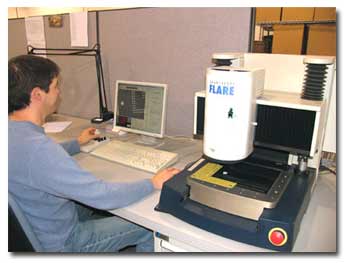
AOI System

AOI System
We use X-rays for verifying BGA solder connection. We use OGP for automatic optical inspection of critical features. We use the CheckSum Model TR-4 Manufacturing Defects Analyzer System to test assemblies to find manufacturing defects such as opens, shorts, and components with incorrect orientation. The CheckSum Model TR-4 Test System provides a flexible software environment to solve unique testing problems. The System makes high-speed measurements for opens and shorts, resistances, capacitances, inductances, voltages and semiconductor junctions. For each test it takes a measurement of a pair of test points in the unit-under-test (UUT) and compares the outcome against individual, user-specified upper and lower test limits. The System software provides the ability to program the test sequence for a UUT. The System can self-learn some UUT attributes, such as opens and connections, diode mapping for IC orientation and presence. Once a UUT is tested, various test reports can be generated. Ironwood specializes in test adapters which can be used to interface the MDA tester and the UUT during high volume MDA test. The CheckSum Model TR-4 Manufacturing Defects Analyzer has been designed to effectively measure a variety of components, both out-of-circuit and in-circuit and accommodate the variety of in-circuit conditions that can occur. The System offers several measurement methods and options. The System contains two separate measurement modes:
Current Mode – Uses a DC constant-current stimulus for taking measurements. The Current Mode uses a precision constant-current source in conjunction with a voltage measurement capability to effectively test resistors, semiconductor junctions, and capacitors.
Voltage Mode – Uses either AC or DC voltage stimulus for taking measurements. The Voltage Mode provides the capability to measure resistors, capacitors and inductors. It can measure using DC voltage or AC frequencies of 100 Hz and 1 KHz as stimulus.
We have custom marking capabilities using laser and serialization options for traceability. We supply parts in panel for further end user assembly requirements. We also have de-panelizer which separates panels into individual unit which then can be packaged in ESD bags, bulk, custom box, tubes, trays and Tape & Reel per customer specification. In a nutshell, we do low to medium volume specialty assembly with best price in town. Here are the examples of solutions we have provided to various customers:
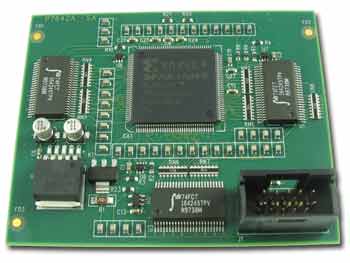
Upgrade Module

Upgrade Module
Upgrade module shown to the left consists of QFP device, few SOIC device, connector, discrete devices, etc. on the top side and PLCC plug on the bottom side. This sub system plugs into PLCC socket on the main board thus upgrading the system without redesigning. This is a good example that shows our capability of double sided assembly with a mix of thru hole and SMT.
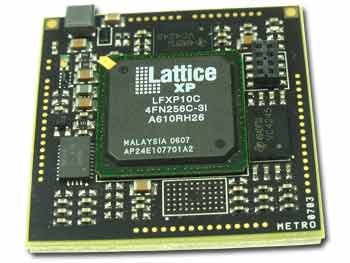
Daughter Card Module

Daughter Card Module
Daughter card module shown to the right consists of primary BGA device and other discrete devices on the top side and Ironwood’s proprietary solder column technology on the bottom side. This sub system has to be reflow assembled on the main board. This shows our BGA assembly capability.
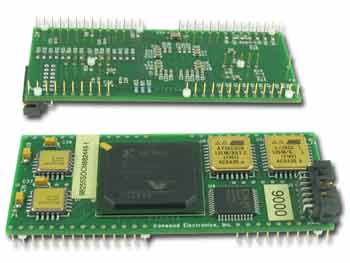
Xilinx BGA Device

Xilinx BGA Device
This subsystem consists of primary Xilinx BGA device in addition to QFP devices and other discrete devices. This unit has many passive SMT devices on the bottom side showing our capability in double sided SMT assembly. In addition, the bottom side of the unit has thru hole pins for mating into main system board. Ironwood’s turn-key solution saves cost, time and resources for customers.
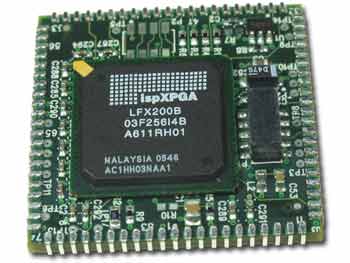
Upgrade Module with BGA Device

Upgrade Module with BGA Device
Upgrade module shown to the right consists of primary BGA device and other discrete devices on the top side and Ironwood’s edge clip technology on the bottom side. This sub system plugs into PLCC socket on the main board thus upgrading the system without redesigning. This shows our capability in integrating multiple technologies to create a subsystem suitable for end customer need not just another contract manufacturing assembly house.
Simple custom modules can be obtained using the typical process flow to the left. Complexities in the requirement changes lead time of each section appropriately.
Please contact our customer support at 800-404-0204 to get an Ironwood project engineer for your specific requirement.
